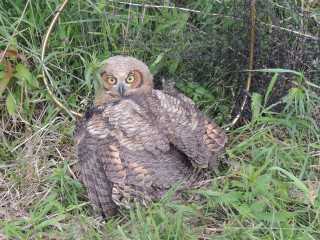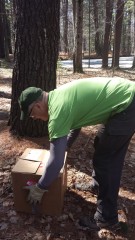
This young great horned owl is old enough to be out of the nest. Note the adult feathers on the wings. He would have been old enough to begin flying at this age, but suffered a broken foot.
When you find an injured or orphaned bird…
First, it is important to determine whether or not the bird is truly injured or orphaned. If it is an adult bird that can not fly away when humans approach, there is usually an injury, and the bird needs help. If it is a young bird, there is a very good chance that it does not need help. Most baby songbirds leave the nest well before they can fly. The parent birds call to them and encourage the young birds to run toward the adult, flapping the wings, in order to receive food. This is repeated many times from greater and greater distances until the fledgling begins to fly. It is a vulnerable stage, and an important time to keep dogs, cats, and other inquisitive creatures away from the young birds to allow time for them to go through this stage of development. If an uninjured fledgling is found in an awkward location, such as a sidewalk or parking lot, it can often be placed in a dense bush nearby; the parents will usually continue to care for it.
Young great horned owls leave the nest four to six weeks before they can fly. They hop around on the ground at night chasing bugs and worms, and other small creatures while learning to hunt. As dawn approaches, the young owl will scramble up a tree trunk using its sharp talons to dig into the bark, and flap its wings to push itself up the tree. The young owl will usually hide next to the tree trunk during the day. These young owls are brought food and are monitored by the parent owls, who will protect them fiercely if given a chance. The parent owl will, however, leave the area if humans are present. In order to determine whether or not a young owl needs help, the finder may need to check the site periodically for several days from a distance, in the evening, with the help of binoculars. Young owls that do not need our help should be left alone. The parents will care for them much better than any human.
To Capture an Owl or Hawk that Needs Help:
1. Find a cardboard box that is about twice as big as the owl. Find a flat piece of cardboard that is as large as the base of the box. Have duct tape or other strong tape available. Cut holes in the side of the box for air circulation.
2. Wearing leather gloves as a precaution, place the box over the hawk or owl. If the bird is able to move much or fly at all, it helps to have someone come in from the opposite side and distract the bird during the capture. Caution!! Many birds of prey will throw themselves on their back and put their talons toward you to defend themselves. The talons are much more dangerous than their beaks. Keep hands away from the bird!!
3. Slide the flat piece under the box; allowing the bird to adjust itself on top of the flat piece of cardboard. Tape the box to the flat piece of cardboard. If the bird is extremely weak, make sure it has righted itself. Birds can not breath well while on their backs. If the bird has much strength, it will adjust to an upright position on its own.
4. Call us for help in transport. We do have volunteers in various parts of the state, but they are volunteers and are not always available. If you are willing to transport the hawk or owl to our facility, that helps tremendously. Call to set up transportation at (989) 772-1538. CAUTION!! If the hawk or owl is near a highway or busy road, call 911 for help before trying to capture the bird. Your own safety and safety of others on the road comes first!

Cardboard boxes are excellent enclosures for transporting hawks and owls. Feather damage is usually minimal, and the box can be disposed of after use. Make sure the box has holes cut in the sides (near the bottom) for air circulation.